Chronic wasting disease (CWD), often referred to as “zombie deer disease,” has been a cause for concern among wildlife and health experts. This transmissible spongiform encephalopathy affects deer and other cervids, leading to significant neurological deterioration. The main concern is whether CWD can infect humans and pose serious health risks.
Recent studies have shown the potential for CWD to cross the species barrier, much like mad cow disease did in the past. Cases of humans contracting sporadic Creutzfeldt-Jakob disease (CJD), which shares similar prion characteristics with CWD, have sparked discussions in the scientific community. While no direct transmissions to humans have been confirmed, the possibility has led to increased monitoring and research efforts.
Understanding CWD and its implications for humans is crucial. The disease’s spread across North America highlights the need for robust detection and safety measures. As scientists continue to investigate, keeping informed about advances in treatment and prevention is essential for public health safety.
Key Takeaways
- CWD, known as zombie deer disease, affects the nervous system of cervids.
- The potential for CWD to infect humans is a major concern.
- Ongoing research focuses on detection, prevention, and understanding the disease’s implications.
Understanding Chronic Wasting Disease (CWD)
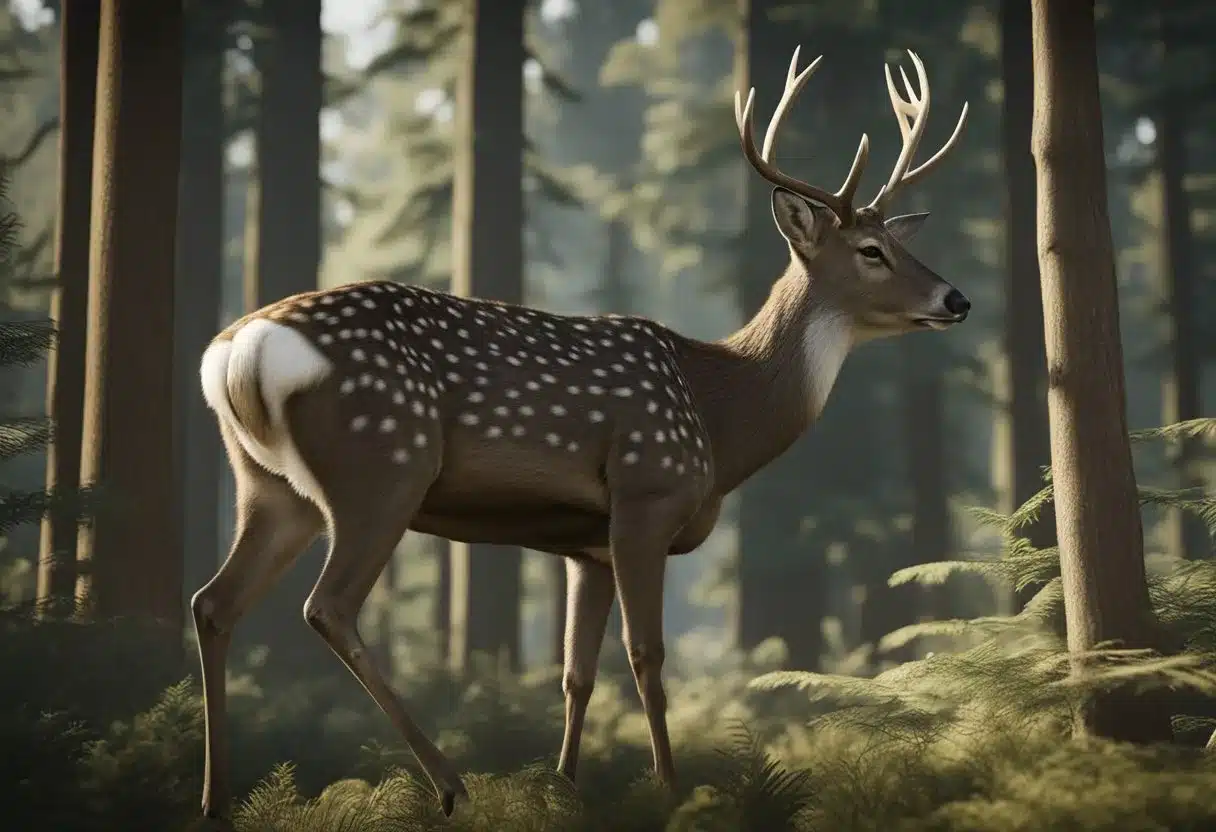
Chronic Wasting Disease (CWD) is a fatal neurological condition affecting deer, elk, and other cervids. It has spread widely across North America and poses a theoretical risk to humans.
What Is Chronic Wasting Disease?
Chronic Wasting Disease is a prion disease that affects members of the deer family, including mule deer, white-tailed deer, elk, and moose.
Prion diseases are caused by misfolded proteins that lead to brain damage. CWD causes severe weight loss, abnormal behavior, and eventually death.
The disease was first identified in captive mule deer in Colorado in the late 1960s. Since then, it has spread to wild cervid populations in many U.S. states and Canadian provinces, including regions in and around Yellowstone National Park[1] and Wyoming.
The Biological Mechanism of CWD
CWD is caused by prions, which are infectious proteins that trigger normal proteins to fold abnormally. These prions accumulate in the brain and other tissues, leading to cell damage and neurological symptoms.
Infected animals typically show signs such as drastic weight loss, stumbling, lack of coordination, drooling, excessive thirst, and listlessness.
The prions responsible for CWD are highly resilient, able to persist in the environment for years. They can be transmitted through direct animal-to-animal contact or indirectly through contaminated soil, plants, or water. There is currently no treatment or vaccine for CWD, making it a concern for wildlife management and conservation efforts.
History and Geographic Spread of CWD
CWD was first recognized in 1967 in a research facility in Colorado. It has since spread geographically to numerous states and regions across North America.
By the 1990s, CWD had been detected in wild elk and deer in several locations. The disease has been reported in areas such as Wyoming, Colorado, and parts of Saskatchewan.
Presently, CWD is found in multiple states and provinces, including regions near Yellowstone National Park[2]. Efforts to control its spread involve culling infected herds and restricting the movement of potentially contaminated animal parts.
Understanding the disease’s dynamics is critical for effective wildlife management and protection of cervid populations.
The Zoonotic Potential of CWD

Chronic Wasting Disease (CWD) is a significant concern due to its potential to jump from deer to humans. Understanding its zoonotic potential, comparisons with other prion diseases, and ongoing research efforts help provide clarity on this issue.
Can CWD Jump the Species Barrier?
CWD is a prion disease that affects deer and elk. The key concern is whether these prions can infect humans. Prion diseases occur when misfolded proteins cause damage to brain tissue. While CWD has not yet been confirmed in humans, similar prion diseases, such as mad cow disease[3], have crossed the species barrier before.
Preliminary studies, including those by the World Health Organization[4], suggest that it is theoretically possible for CWD prions to infect humans. These studies raise alarms because of the similarities between CWD and other zoonotic prion diseases.
Comparative Analysis with Other Prion Diseases
Comparing CWD to diseases like Creutzfeldt-Jakob Disease (CJD)[3] and Bovine Spongiform Encephalopathy (BSE), or mad cow disease, is crucial in understanding its risks. CJD also involves misfolded prions but typically occurs sporadically in humans. BSE, however, moved from cattle to humans, causing a form of CJD known as vCJD.
The Centers for Disease Control and Prevention (CDC)[5] emphasize that humans contracted vCJD by consuming infected beef. Current experts worry that venison from affected deer could pose a similar risk if CWD prions exhibit the ability to affect human cells.
Research on CWD Transmission to Humans
Ongoing research seeks to determine if CWD can indeed be zoonotic. Studies using animal models like monkeys have shown that CWD prions can cause disease under certain laboratory conditions. This suggests a potential risk to humans.
Scientists from Texas have documented cases where hunters consuming infected venison developed symptoms akin to prion diseases, raising public health concerns. Organizations like the National Institutes of Health[5] fund studies to monitor and evaluate these risks.
Overall, experts remain cautious but vigilant in investigating the zoonotic potential of CWD to mitigate any risk to human populations.
Detecting and Monitoring CWD
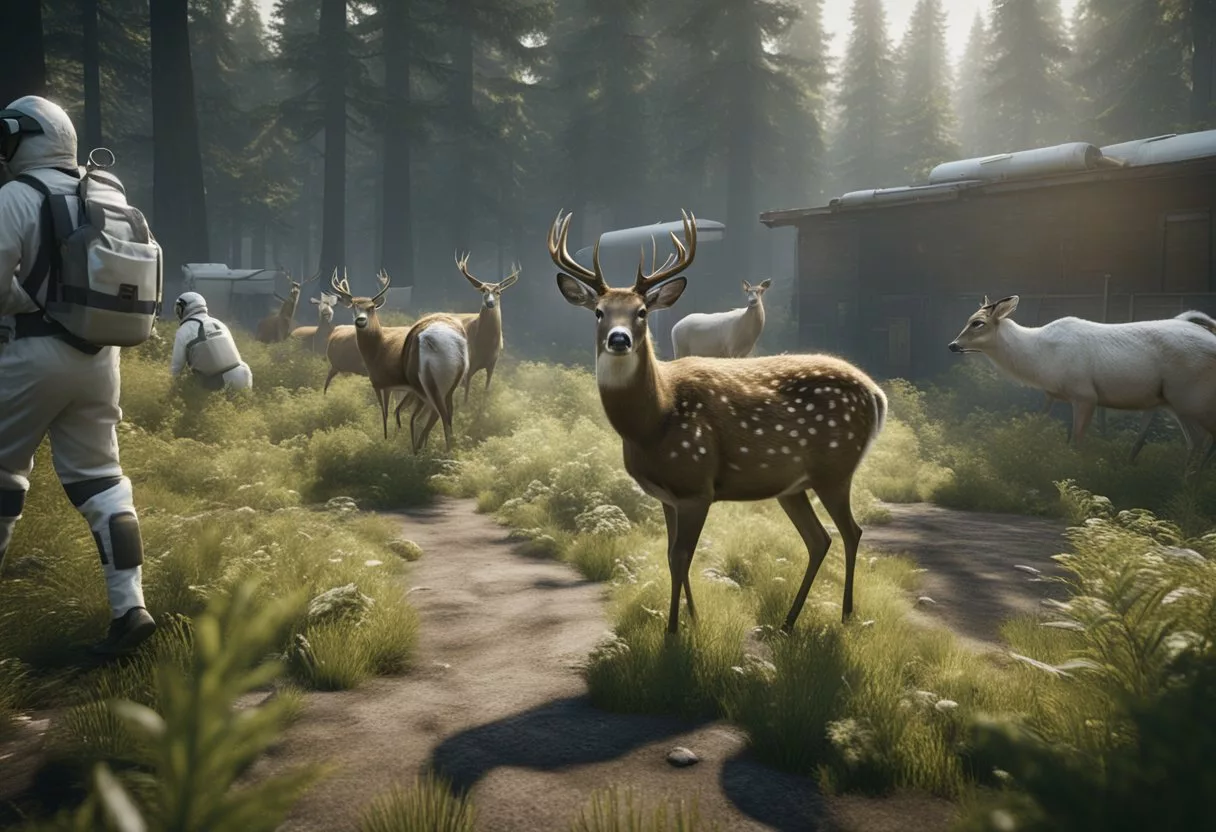
Detecting and monitoring Chronic Wasting Disease (CWD) involve different methods for surveillance, testing, and public health strategies. Researchers work to improve detection while facing challenges such as identifying the disease early and ensuring accurate testing.
Surveillance and Testing Methods
Surveillance is essential for understanding and controlling CWD. The process includes collecting samples from deer, elk, and other cervids. Testing methods like enzyme-linked immunosorbent assay (ELISA) and immunohistochemistry (IHC) are commonly used to detect prions. These tests focus on lymph nodes, brain tissues, and tonsils to confirm the presence of the disease. Many states work with the Centers for Disease Control to implement statewide surveillance programs, which help monitor disease prevalence and detect outbreaks early.
Challenges in CWD Detection
CWD detection faces challenges such as the disease’s long incubation period, which can last years. Early symptoms are often subtle, making it difficult to identify infected animals before they spread the disease. Many areas lack adequate testing facilities, creating delays in diagnosis. False negatives can occur if the sample does not contain enough prions. Public health organizations are pushing for more advanced and rapid testing methods. Institutions like the University of Minnesota’s Center for Infectious Disease Research and Policy play a crucial role in researching better detection techniques.
Public Health Surveillance Strategies
Public health surveillance strategies aim to protect both animal and human health. Government agencies, including the Centers for Disease Control, coordinate with wildlife agencies to track CWD. Strategies involve contingency plans for outbreaks and informing the public about the risks. Surveillance also includes testing hunter-harvested animals and monitoring high-risk areas where the disease is prevalent. Educating hunters and the public about safe practices is critical to prevent potential spread to humans.
Detecting and monitoring CWD is a complex task that requires coordinated efforts from multiple agencies and constant advancement in testing and surveillance techniques. The ongoing research and policies aim to manage and eventually eradicate the disease while ensuring public safety.
Environmental Implications of CWD

Chronic Wasting Disease (CWD) can have serious effects on the environment, wildlife, and ecosystems. The disease affects deer populations, leading to significant ecological changes.
Impact on Ecosystems and Wildlife Populations
CWD impacts ecosystems by altering the dynamics of wildlife populations. Infected deer may show symptoms like drooling, lethargy, and stumbling, which makes them more vulnerable to predators. As a result, deer populations can drastically decline.
Healthy deer are crucial for controlling vegetation. A decline in their numbers can lead to overgrowth of certain plants, disrupting the balance of the ecosystem. Other animals that depend on deer, such as predators and scavengers, may also be affected.
Furthermore, CWD[1] has been detected in over 800 deer samples, suggesting a widespread issue. The disease also creates problems for wildlife management, making it harder to maintain healthy herds.
Role of Environment in CWD Propagation
The environment plays a significant role in the spread of CWD. Contaminated soil and water sources are key factors. Deer often shed prions, the infectious proteins responsible for CWD, through bodily fluids. These prions can persist in the environment for years, contaminating soil and water.
Plants in contaminated soil may also absorb prions. When other deer consume these plants, the disease spreads further. This environmental contamination makes it challenging to control the disease’s spread.
Efforts to manage CWD[6] include restricting deer movements and decontaminating affected areas. However, the persistent nature of prions complicates these efforts. Understanding how the environment contributes to CWD spread is essential for effective management and mitigation strategies.
Human Health Risks and Safety Measures
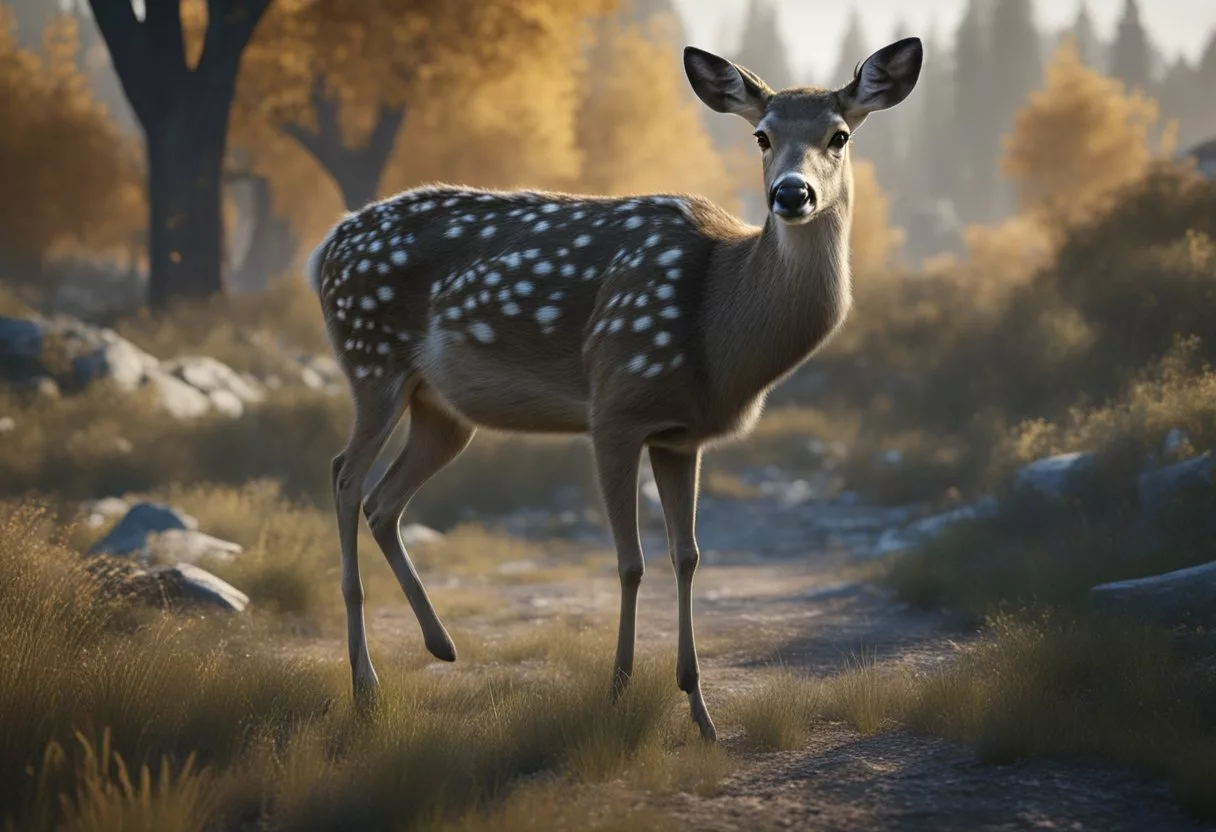
Chronic Wasting Disease (CWD), often called “zombie deer disease,” poses potential health risks to humans, particularly through the consumption of infected venison. Hunters need to follow specific guidelines to prevent the spread of this disease and to ensure food safety.
Consumption of Infected Venison
Eating venison from infected deer may present human health risks. Research has shown that while it is not yet clear if CWD can affect humans, two hunters’ deaths in 2022 raised concerns about this possibility (USA TODAY[7]).
Testing venison before consumption is crucial. Hunters should avoid eating venison from deer that appear sick or act strangely. They should also wear gloves when dressing deer and thoroughly wash hands and tools afterward. Cooking the meat properly can help reduce the risk, although there is no guarantee it will eliminate the infectious proteins known as prions.
Guidelines for Hunters and the General Public
Hunters play a crucial role in preventing the spread of CWD. They should report any deer that appear sick and follow responsible hunting practices. Using gloves when handling bodily fluids and properly disposing of remains can help reduce risks.
Avoiding hunting in known CWD areas is advisable. If hunting in these areas, testing the deer for CWD before consumption is recommended. Public health authorities regularly provide updates on known CWD regions, and staying informed can prevent unnecessary risks.
For the general public, awareness and education about CWD are vital. People should be cautious about accepting venison from unknown or untested sources. Public health campaigns can help spread information on the safety measures necessary to prevent potential human health risks.
Advances in Treatment and Prevention
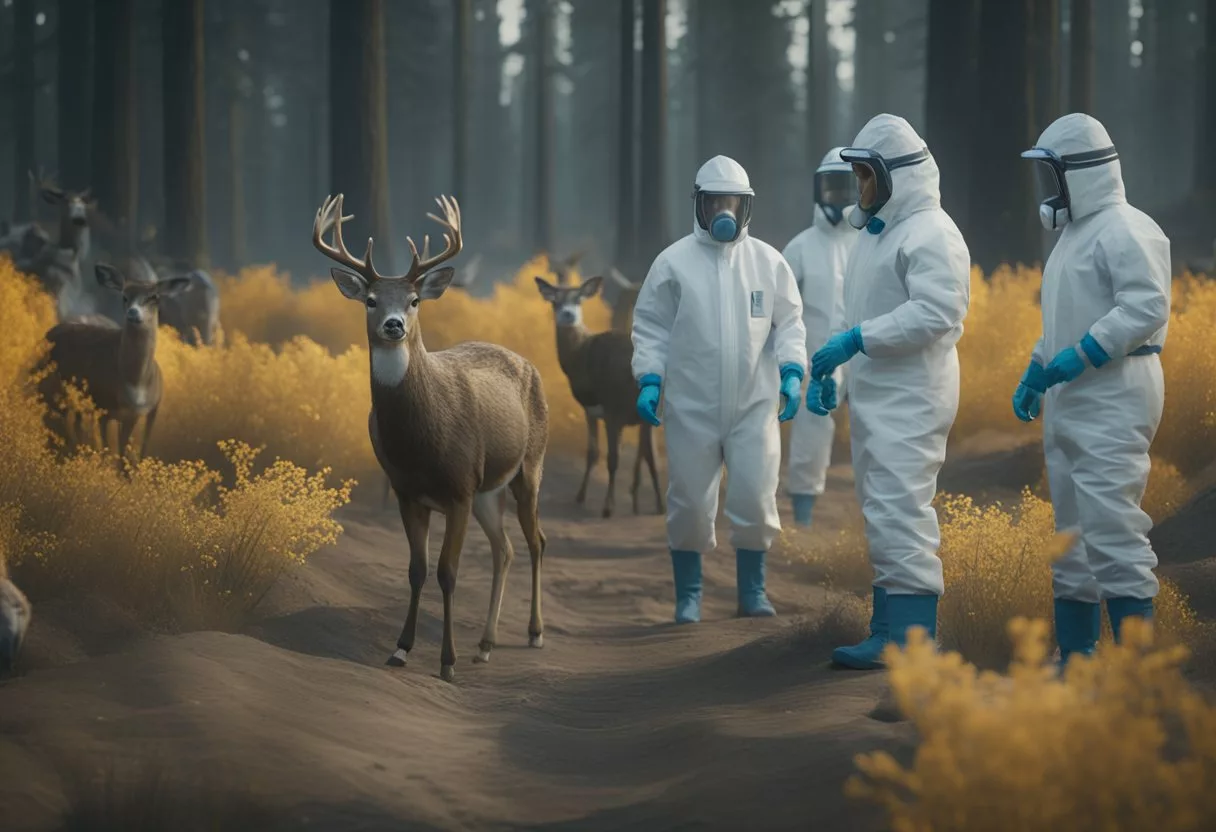
Efforts to combat zombie deer disease focus on researching potential treatments, developing vaccines, and implementing public policies to mitigate its spread. Here’s a closer look at these key areas.
Current Research on Therapeutics
Researchers are exploring various treatments for chronic wasting disease (CWD), commonly called zombie deer disease. As of now, there is no cure, but scientists are studying antibodies that may slow the brain deterioration in infected deer.
Some studies are looking at antiviral drugs that target the prions causing the disease. Important areas of investigation include prevention of prion transmission and slowing disease progression in infected animals. Much of this research is in early stages and is mainly conducted in lab settings.
Potential for Vaccine Development
Developing a vaccine against CWD is a major goal for scientists. A successful vaccine could drastically reduce the prevalence of the disease in deer populations.
Researchers are trying to produce vaccines that trigger an immune response against prions. Some promising vaccine trials showed initial success in laboratory settings. Creating a stable, widely distributable vaccine that works in wild deer populations remains a challenge due to genetic diversity and delivery difficulties.
Mitigation Strategies and Public Policy
Public health and wildlife agencies are actively working on strategies to mitigate the spread of CWD. Policies like banning the transportation of infected deer and regulating deer farming practices are in place.
Public awareness campaigns educate hunters and the public about preventing disease spread. Contingency plans include monitoring deer populations and rapid response to new outbreaks. Efforts to mitigate the disease focus on controlling its prevalence and preventing human infection through strict regulations and public cooperation.
Looking to the Future
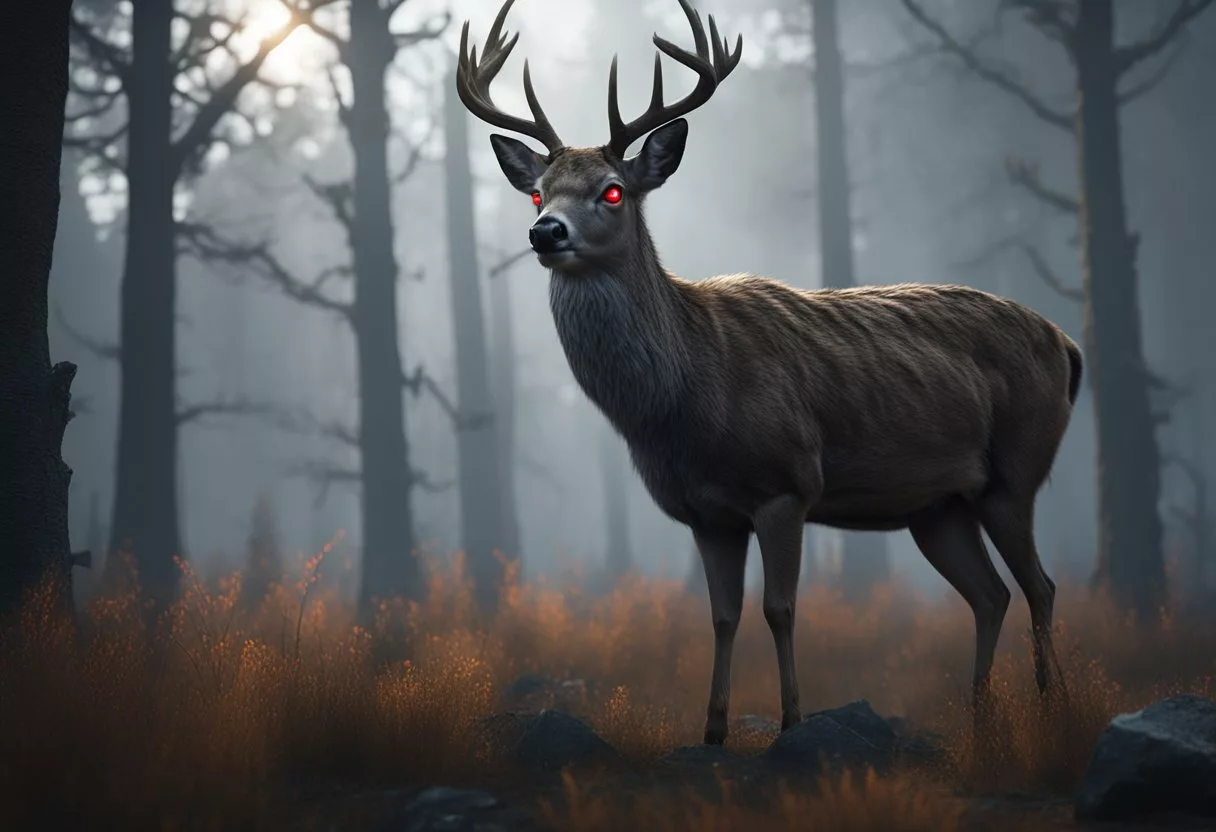
Researchers are focusing on better ways to control zombie deer disease and explore innovative methods to manage and reduce its spread. Key areas of focus include advancing chronic wasting disease (CWD) research and improving disease management techniques.
The Road Ahead for CWD Research and Control
CWD research is receiving increased attention from organizations like the National Institutes of Health. They are supporting studies on how the disease spreads and the risk it poses to humans.
A significant focus is on surveillance. Experts are tracking the spread of infectious prions in various animal populations like hay, voles, and raccoons. Studying these environments helps scientists predict future outbreaks.
Foresight is critical for preparing and responding. By analyzing the spread patterns, scientists are hoping to devise strategies to control the disease. This ongoing research will potentially offer new insights into how to protect public health and manage affected wildlife populations.
Innovations in Disease Management
Improving disease management is essential in controlling the spread of CWD. Innovative methods are being developed to monitor and manage the disease effectively.
One approach includes creating more effective field tests for early detection. These tests can identify infected deer before they show symptoms, allowing for quicker response.
Efforts are also being made to develop treatments or vaccines for CWD. While these are in early stages, they represent a hopeful future for disease management.
Public health initiatives are also being expanded to educate hunters and the general public about the risks associated with CWD. Precautionary measures, such as proper handling and disposal of potentially infected carcasses, are crucial steps in preventing the spread.
These combined efforts aim to curb the impact of CWD and ensure the well-being of both wildlife and humans.
Frequently Asked Questions

Zombie deer disease, or chronic wasting disease (CWD), is a significant concern in 2024. This FAQ addresses key points about human risks, symptoms in deer, current status, transmission, safety, and prevention.
Can humans contract chronic wasting disease from affected deer?
There is no confirmed case of humans contracting CWD from deer. However, experts remain concerned about the potential for transmission due to the similarities between CWD and other prion diseases, like Creutzfeldt-Jakob disease (CJD). More research is needed to fully understand the risks.
What are the known symptoms of chronic wasting disease in cervids?
CWD affects the nervous system of cervids like deer, elk, and moose. Infected animals may drool, stumble, and appear emaciated and uncoordinated. Their brains deteriorate to a spongy consistency, leading to these symptoms before they eventually die.
What is the current status of zombie deer disease in 2024?
As of 2024, CWD continues to spread among deer populations in the United States and Canada. New cases have been reported in northern Maryland and other areas, prompting ongoing studies and monitoring by scientists and public health officials.
How is chronic wasting disease transmitted among deer populations?
CWD is mainly transmitted through direct animal-to-animal contact or by exposure to contaminated environments, such as soil or water with infectious prions. The disease can persist in the environment for years, making it challenging to control.
What are the recommended safety precautions for handling deer that may be infected with CWD?
When handling potentially infected deer, it is recommended to wear protective gloves and avoid contact with the animal’s brain, spinal cord, eyes, or lymph nodes. Hunters should consider testing deer meat before consumption and follow local guidelines about CWD.
What measures are being taken to prevent the spread of chronic wasting disease?
Efforts to prevent the spread of CWD include monitoring and testing wild and farmed deer populations, imposing restrictions on moving potentially infected animals, and educating hunters and the public about the disease. Research into vaccines and more effective management strategies is ongoing.
References
- As ‘Zombie’ Deer Disease Spreads, Scientists Look for Answers. https://e360.yale.edu/features/chronic-wasting-disease-deer Accessed October 25, 2025
- About Chronic Wasting Disease (CWD) | CWD. https://www.cdc.gov/chronic-wasting/about/index.html Accessed October 25, 2025
- Does 'zombie deer disease' pose risks for humans?. https://www.bbc.com/future/article/20240219-zombie-deer-disease-risks-for-humans Accessed October 25, 2025
- 404. https://www.who.int/news-room/fact-sheets/detail/prion-diseases Accessed October 25, 2025
- As 'zombie deer disease' spreads, experts worry about risk for humans. https://www.usatoday.com/story/news/nation/2024/02/22/zombie-deer-disease-humans/72696499007/ Accessed October 25, 2025
- Zombie Deer Disease Is Spreading Through America. Here's Why It's a Concern. : ScienceAlert. https://www.sciencealert.com/zombie-deer-disease-is-spreading-through-america-heres-why-its-a-concern Accessed October 25, 2025
- 'Zombie deer disease': Study of 2 hunter deaths raises concerns. https://www.usatoday.com/story/news/nation/2024/04/19/zombie-deer-disease-hunters-died-infected-venison/73384647007/ Accessed October 25, 2025
